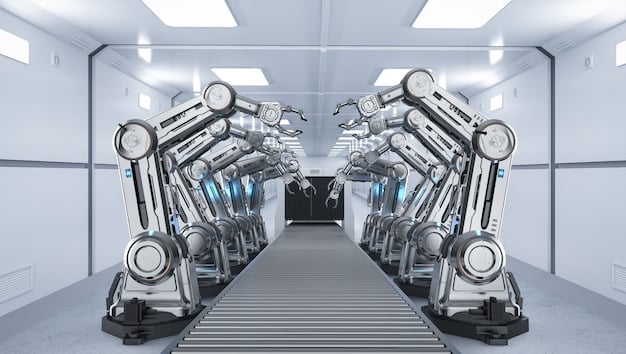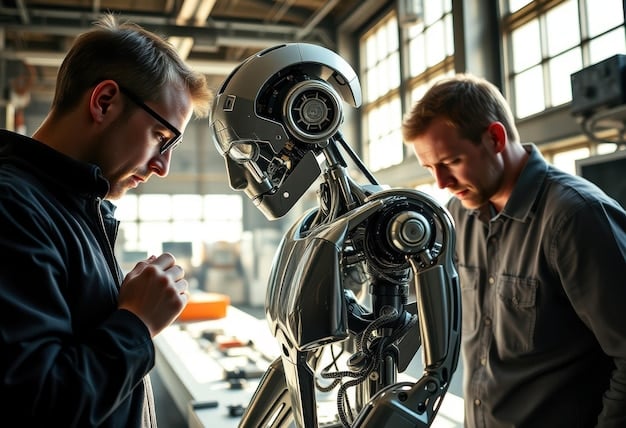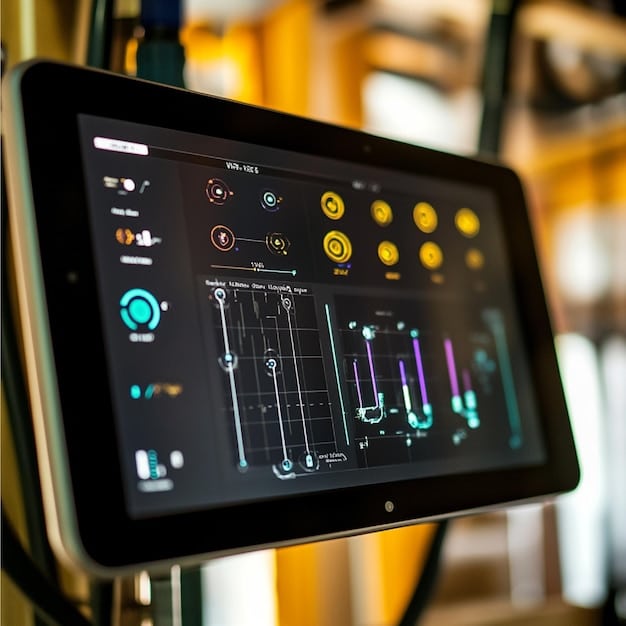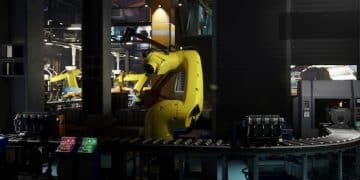The Latest Advancements in Robotics and Automation in US Manufacturing

The Latest Advancements in Robotics and Automation in US Manufacturing are revolutionizing production lines, enhancing efficiency, and reshaping the workforce landscape across various sectors in the United States.
The manufacturing sector in the US is undergoing a massive transformation, largely fueled by the latest advancements in robotics and automation. These technologies are not just about replacing human workers; they’re about creating more efficient, safer, and more productive manufacturing processes.
So, what are the key innovations driving this change, and what impact are they having on American manufacturing? Let’s delve into the specifics, exploring the cutting-edge robotics and automation solutions that are reshaping the industry.
Exploring The Latest Advancements in Robotics and Automation in US Manufacturing
The latest advancements in robotics and automation in US manufacturing are significantly changing how products are made, impacting various industries from automotive to aerospace. Understanding these technologies is crucial for businesses looking to stay competitive.
Collaborative Robots (Cobots)
Cobots are designed to work alongside human workers, enhancing productivity and safety. They are equipped with sensors and software that allow them to detect and respond to human presence, making them safe for close interaction.
- Increased safety in the workplace
- Enhanced productivity through human-robot collaboration
- Flexibility in manufacturing processes
The integration of cobots is enabling manufacturers to optimize their operations, combining the precision and speed of robots with the problem-solving and dexterity of human workers. This collaboration is particularly valuable in tasks that require both repetitive motion and human judgment.

In conclusion, collaborative robots are changing the manufacturing landscape by fostering a safer, more adaptable, and productive work environment. This technology improves workflow, resulting in overall efficiency.
The Role of Artificial Intelligence in Automated Manufacturing
AI is at the core of intelligent automation, enabling machines to learn, adapt, and make decisions autonomously. This is particularly impactful in manufacturing, where AI-powered systems can optimize processes, predict maintenance needs, and improve product quality.
Predictive Maintenance
AI algorithms can analyze data from sensors on machinery to predict when maintenance is needed before a breakdown occurs. This reduces downtime and extends the lifespan of equipment.
With real-time monitoring, manufacturers can identify subtle changes in machine performance that may indicate future problems. This proactive approach allows for scheduled maintenance, preventing costly repairs and ensuring continuous operation.
Quality Control
AI-powered vision systems can inspect products with greater accuracy than human inspectors. They can identify defects and inconsistencies that may be missed by the human eye, ensuring higher product quality.
- Enhanced product quality through precise inspections
- Reduced waste by identifying defects early in the production process
- Improved customer satisfaction through consistent product quality
In essence, artificial intelligence enhances automated manufacturing by predictive maintenance and improving quality control. As AI technology develops, its role in US manufacturing will expand.
Advanced Sensors and IoT Integration in Manufacturing Processes
The integration of advanced sensors and the Internet of Things (IoT) is transforming manufacturing by providing real-time data on every aspect of the production process. This data can be used to optimize operations, improve efficiency, and enhance decision-making.

Real-Time Monitoring
Sensors can monitor temperature, pressure, vibration, and other critical parameters in real-time. This data is transmitted to a central system where it can be analyzed and used to make adjustments to the production process.
This continuous monitoring allows for immediate responses to any deviations from the norm, preventing potential issues from escalating. By identifying and addressing problems in real-time, downtime is minimized and productivity is maximized.
Data Analytics and Optimization
The data collected from sensors and IoT devices can be analyzed to identify patterns and trends. This information can be used to optimize production processes, reduce waste, and improve energy efficiency.
- Improved decision-making through data-driven insights
- Increased efficiency by optimizing resource utilization
- Reduced waste by identifying areas for improvement
Ultimately, the integration of advanced sensors and IoT into manufacturing processes provides manufacturers with the insights and tools they need to optimize their operations and stay competitive. From real-time monitoring to data analytics, this approach unlocks new possibilities for improving efficiency, reducing costs, and boosting overall performance.
The Impact of 3D Printing and Additive Manufacturing
3D printing is revolutionizing manufacturing by allowing for the creation of complex parts and products directly from digital designs. This technology is particularly useful for prototyping, custom manufacturing, and producing parts with intricate geometries.
Prototyping
3D printing allows manufacturers to create prototypes quickly and inexpensively. This accelerates the product development process and allows for more experimentation and innovation.
By enabling rapid prototyping, manufacturers can test and refine their designs more efficiently. This reduces the time and cost associated with traditional prototyping methods, accelerating the pace of innovation and time to market.
Custom Manufacturing
3D printing enables manufacturers to produce customized products tailored to the specific needs of individual customers. This opens up new opportunities for personalization and product differentiation.
- Ability to create customized products on demand
- Reduced lead times for customized orders
- Enhanced customer satisfaction through personalized products
In conclusion, 3D printing and additive manufacturing allow for product customization, shortens production times, and encourages experimentation, making it a key element of the latest advancements in robotics and automation in US manufacturing.
Skills and Workforce Development for Automated Manufacturing
As manufacturing becomes increasingly automated, there is a growing need for workers with the skills to operate, maintain, and program robotic systems. Investing in workforce development is essential to ensure that the US manufacturing sector has the talent it needs to thrive.
Training Programs
Manufacturers, educational institutions, and government agencies are collaborating to develop training programs that provide workers with the skills they need to succeed in automated manufacturing environments.
These programs often include hands-on training with robotic systems, as well as instruction in programming, maintenance, and troubleshooting. By equipping workers with these skills, manufacturers can ensure that they have the talent they need to operate and maintain their automated systems effectively.
STEM Education
Encouraging students to pursue careers in STEM fields (science, technology, engineering, and mathematics) is essential for building a workforce with the skills needed for automated manufacturing.
- Cultivating interest in STEM fields from an early age
- Providing students with the knowledge and skills needed for careers in automated manufacturing
- Addressing the skills gap in the manufacturing sector
To conclude, workforce development and STEM education are critical for supporting automated manufacturing. With targeted training and STEM education, the workforce can adapt and maintain a competitive edge.
Challenges and Future Trends in Automation and Robotics
While automation and robotics offer many benefits, there are also challenges that must be addressed. These include the cost of implementation, the potential for job displacement, and the need for ongoing training and support.
Cost of Implementation
Implementing robotic and automated systems can be expensive, particularly for small and medium-sized manufacturers. However, the long-term benefits of increased productivity and efficiency can outweigh the initial investment.
To help manufacturers overcome this hurdle, government incentives, tax credits, and financing options are available to reduce the upfront costs associated with automation. By leveraging these resources, manufacturers can make automation more accessible and affordable, realizing the productivity and efficiency gains it offers.
Job Displacement
There is concern that automation and robotics could lead to job displacement, particularly for workers in repetitive or low-skilled roles. However, many experts argue that automation will create new jobs in areas such as robotics programming, maintenance, and data analytics.
- Emphasis on reskilling and upskilling initiatives
- Creation of new job roles in robotics and automation
- Focus on human-machine collaboration to leverage the strengths of both
In the future, the latest advancements in robotics and automation in US manufacturing will depend on effectively managing challenges such as high costs and job displacement. By addressing these challenges proactively, manufacturers can harness the transformative power of automation and robotics.
| Key Element | Brief Description |
|---|---|
| 🤖 Cobots | Robots working alongside humans for increased efficiency. |
| 💡 AI | Artificial intelligence optimizing processes and predicting maintenance. |
| 🌐 IoT | Real-time data via sensors optimizing production & decision-making. |
| 🖨️ 3D Printing | Rapid prototyping and custom manufacturing on demand. |
Frequently Asked Questions
Implementing automation can lead to increased efficiency, reduced costs, improved product quality, and enhanced safety in the workplace. These benefits collectively contribute to a stronger competitive edge.
Cobots are designed to work safely alongside humans, while traditional industrial robots typically require safety cages and are used for tasks that are too dangerous or repetitive for humans.
AI enhances automation through predictive maintenance, quality control, and process optimization. These AI-driven improvements lead to reduced downtime and improved product consistency.
Challenges include the high initial investment costs, potential job displacement, and the need for ongoing training and support to ensure that workers have the skills to operate and maintain these systems effectively.
Companies can invest in training programs, promote STEM education, and foster a culture of lifelong learning. These efforts equip workers with the skills needed to succeed in automated environments.
Conclusion
The latest advancements in robotics and automation in US manufacturing are paving the way for a more efficient, productive, and competitive manufacturing sector. Embracing these technologies is crucial for businesses looking to thrive in the modern economy.
By investing in robotics, AI, IoT, and workforce development, US manufacturers can unlock new opportunities for growth and innovation while creating high-value jobs and strengthening the nation’s industrial base. Automation is not just the future of manufacturing – it’s the present.





